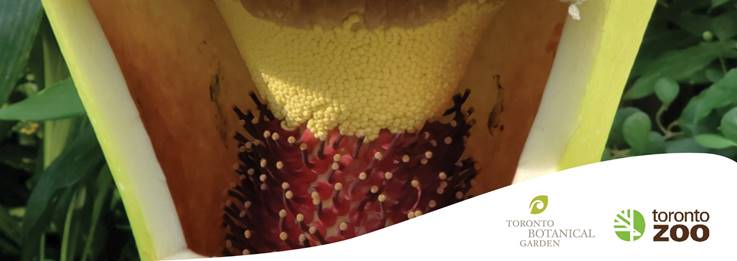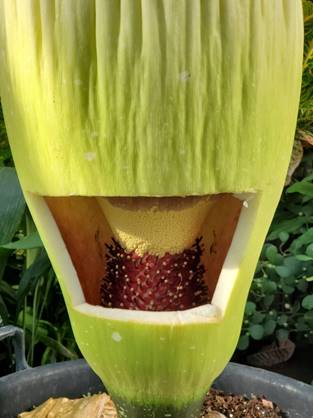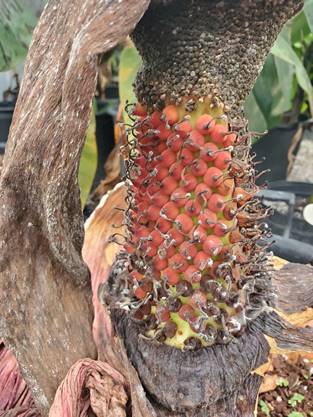
TORONTO ZOO & TORONTO BOTANICAL GARDEN
WORK TOGETHER ON APPLIED RESEARCH FOR AMORPHOPHALLUS TITANUM POLLINATION


Left: Corpse flower ‘Vincent’ with male (top) and female (bottom) inflorescence exposed for pollen collection
Right: Red berries forming on ‘Vincent’s’ spadix, Photo Credit: Toronto Zoo

TORONTO, ON, Thursday, September 17, 2020: On Sunday, August 9, 2020, your Toronto Zoo and Toronto Botanical Garden collaborated to save to help preserve genetic material from a blooming corpse flower (Amorphophallus titanum). This rare flower is one of Sumatra’s most coveted and threatened plants.
Earlier this month when our corpse flower ‘Vincent Van Gross’ appeared to be ready to bloom, our Zoo’s Horticulture and Reproductive Science teams connected with Toronto Botanical Garden to prepare to cross-pollinate the corpse flower. This cross-pollination would be completed with preserved pollen from Pablo “Pe-ew” Caso, who was your Toronto Zoo’s first-ever corpse flower that bloomed in September 2018.
The Zoo’s Reproductive Sciences team collected and stored pollen from ‘Pablo’ and froze it using two techniques to ensure successful long term storage. One pollen sample was stored at -80 °C, and another was cryogenically frozen in liquid nitrogen at -196 °C. This was done to ensure we preserved the genetic material and could pollinate future Amorphophallus titanum blooms in the collection.
This was not our team’s first attempt at this procedure. In August of 2019, the Zoo had the opportunity to work with McMaster University on a cross-pollination attempt using ‘Pablo’s’ frozen pollen on their blooming corpse flower ‘Arthur’ to determine if cryogenics can provide a viable long term storage solution. Although ‘Arthur’ was not successful in seed production, our research teams learned a great deal and provided us the critical information to expand our knowledge.
When ‘Vincent’ began to bloom this year, your Zoo and TBG staff joined forces to continue this exciting research. In the early morning on Monday, August 10, 2020, four treatments of ‘Pablo’s’ frozen pollen were thawed and prepared to use for the pollination. ‘Vincent’s’ female flower, the inflorescence, was divided into a grid to allow Zoo and TBG researchers to attempt cross-pollination, using two treatments of pollen that had been cryogenically preserved and two treatments that had been stored at -80 °C.
We are excited to share confirmation that red berries have begun forming on ‘Vincent’, indicating the flower accepted the pollen. We will continue to monitor this closely and will be able to confirm if the pollen was viable in six months when seeds should begin on develop on the plant.
The perplexing question behind the corpse flower is the plant’s infrequent blooms, sometimes happening decades apart. The odds that two plants in our care bloom simultaneously are quite low, and therefore, the possibility for cross-pollination is almost non-existent. We are proud of the Toronto Zoo’s Reproductive Sciences team for developing the first-ever protocol for Corpse Flower pollen collection and preservation in 2019.
“Through the use of cryogenic technologies, zoos and other conservation organizations have been able to establish long-term storage or “biobanks” of living cells from genetically rare and endangered species, including plants,” says Paula Mackie, Reproductive Sciences Coordinator, Toronto Zoo. “If frozen correctly, these cells will remain alive in a static-state for the unforeseen future and can be reintroduced to help support the population when needed. Though the Toronto Zoo biobank is currently dominated by animal cells, we are always working to improve the techniques and expand the repertoire of species.”
"I cannot thank our Toronto Zoo Reproductive Sciences team and the Toronto Botanical Garden enough for their flexibility and dedication on this project. This work could pave the way to preserving and expanding the genetics of a vulnerable species not only within your Zoo’s collection, but with many other horticultural institutions for generations to come," says Jesse Raycroft, Supervisor of Horticulture, Toronto Zoo.
“Whenever an Amorphophallus titanum blooms it’s an important horticultural event; worthy of the attention it draws,” says Paul Gellatly, Director of Horticulture, Toronto Botanical Garden and former Curatorial Gardener at the Toronto Zoo. “When the opportunity to partner with the Toronto Zoo; work with, and pollinate Vincent, I was excited to share my passion and knowledge having been part of Pablo “Pe-ew” caso’s pollen collection in 2018. Threatened in its native habitat of Sumatra, the conservation work at the Zoo is crucial not only to the animals, but also for the plants around the world. Toronto Zoo is home to one of Canada’s largest tropical plant collections; the Toronto Botanical Garden looks forward to working closely with the Zoo on future horticultural conservation initiatives,” he added.
Like much of Sumatra's wildlife, including Sumatran orangutans and Sumatran tigers, the Amorphophallus titanium is threatened by habitat loss. Not only is space an issue, but as forests decline, so do hornbills, which are the corpse plant’s primary seed distributor. Thankfully, through advances in horticultural techniques, the intricacies of breeding this unusual plant are slowly being uncovered, allowing us to maintain them in managed care as insurance against loss of their wild population. The Toronto Zoo is home to over 11 Amorphophallus titanum, and 31 other Amorphophallus species.
To learn more about ‘Vincent Van Gross’ and the Amorphophallus titanum,

- 30 -
Media Contact Information:
Toronto Zoo
Katie Gray
Manager of Strategic Communications
[email protected]
Amanda Chambers
Supervisor of Strategic Communications
[email protected]
Toronto Botanical Garden
Jenny Rhodenizer
Director of Marketing & Communication
[email protected]
TORONTO, ON, Thursday, September 17, 2020: On Sunday, August 9, 2020, your Toronto Zoo and Toronto Botanical Garden collaborated to save to help preserve genetic material from a blooming corpse flower (Amorphophallus titanum). This rare flower is one of Sumatra’s most coveted and threatened plants.
Earlier this month when our corpse flower ‘Vincent Van Gross’ appeared to be ready to bloom, our Zoo’s Horticulture and Reproductive Science teams connected with Toronto Botanical Garden to prepare to cross-pollinate the corpse flower. This cross-pollination would be completed with preserved pollen from Pablo “Pe-ew” Caso, who was your Toronto Zoo’s first-ever corpse flower that bloomed in September 2018.
The Zoo’s Reproductive Sciences team collected and stored pollen from ‘Pablo’ and froze it using two techniques to ensure successful long term storage. One pollen sample was stored at -80 °C, and another was cryogenically frozen in liquid nitrogen at -196 °C. This was done to ensure we preserved the genetic material and could pollinate future Amorphophallus titanum blooms in the collection.
This was not our team’s first attempt at this procedure. In August of 2019, the Zoo had the opportunity to work with McMaster University on a cross-pollination attempt using ‘Pablo’s’ frozen pollen on their blooming corpse flower ‘Arthur’ to determine if cryogenics can provide a viable long term storage solution. Although ‘Arthur’ was not successful in seed production, our research teams learned a great deal and provided us the critical information to expand our knowledge.
When ‘Vincent’ began to bloom this year, your Zoo and TBG staff joined forces to continue this exciting research. In the early morning on Monday, August 10, 2020, four treatments of ‘Pablo’s’ frozen pollen were thawed and prepared to use for the pollination. ‘Vincent’s’ female flower, the inflorescence, was divided into a grid to allow Zoo and TBG researchers to attempt cross-pollination, using two treatments of pollen that had been cryogenically preserved and two treatments that had been stored at -80 °C.
We are excited to share confirmation that red berries have begun forming on ‘Vincent’, indicating the flower accepted the pollen. We will continue to monitor this closely and will be able to confirm if the pollen was viable in six months when seeds should begin on develop on the plant.
The perplexing question behind the corpse flower is the plant’s infrequent blooms, sometimes happening decades apart. The odds that two plants in our care bloom simultaneously are quite low, and therefore, the possibility for cross-pollination is almost non-existent. We are proud of the Toronto Zoo’s Reproductive Sciences team for developing the first-ever protocol for Corpse Flower pollen collection and preservation in 2019.
“Through the use of cryogenic technologies, zoos and other conservation organizations have been able to establish long-term storage or “biobanks” of living cells from genetically rare and endangered species, including plants,” says Paula Mackie, Reproductive Sciences Coordinator, Toronto Zoo. “If frozen correctly, these cells will remain alive in a static-state for the unforeseen future and can be reintroduced to help support the population when needed. Though the Toronto Zoo biobank is currently dominated by animal cells, we are always working to improve the techniques and expand the repertoire of species.”
"I cannot thank our Toronto Zoo Reproductive Sciences team and the Toronto Botanical Garden enough for their flexibility and dedication on this project. This work could pave the way to preserving and expanding the genetics of a vulnerable species not only within your Zoo’s collection, but with many other horticultural institutions for generations to come," says Jesse Raycroft, Supervisor of Horticulture, Toronto Zoo.
“Whenever an Amorphophallus titanum blooms it’s an important horticultural event; worthy of the attention it draws,” says Paul Gellatly, Director of Horticulture, Toronto Botanical Garden and former Curatorial Gardener at the Toronto Zoo. “When the opportunity to partner with the Toronto Zoo; work with, and pollinate Vincent, I was excited to share my passion and knowledge having been part of Pablo “Pe-ew” caso’s pollen collection in 2018. Threatened in its native habitat of Sumatra, the conservation work at the Zoo is crucial not only to the animals, but also for the plants around the world. Toronto Zoo is home to one of Canada’s largest tropical plant collections; the Toronto Botanical Garden looks forward to working closely with the Zoo on future horticultural conservation initiatives,” he added.
Like much of Sumatra's wildlife, including Sumatran orangutans and Sumatran tigers, the Amorphophallus titanium is threatened by habitat loss. Not only is space an issue, but as forests decline, so do hornbills, which are the corpse plant’s primary seed distributor. Thankfully, through advances in horticultural techniques, the intricacies of breeding this unusual plant are slowly being uncovered, allowing us to maintain them in managed care as insurance against loss of their wild population. The Toronto Zoo is home to over 11 Amorphophallus titanum, and 31 other Amorphophallus species.
To learn more about ‘Vincent Van Gross’ and the Amorphophallus titanum,

- 30 -
Media Contact Information:
Toronto Zoo
Katie Gray
Manager of Strategic Communications
[email protected]
Amanda Chambers
Supervisor of Strategic Communications
[email protected]
Toronto Botanical Garden
Jenny Rhodenizer
Director of Marketing & Communication
[email protected]